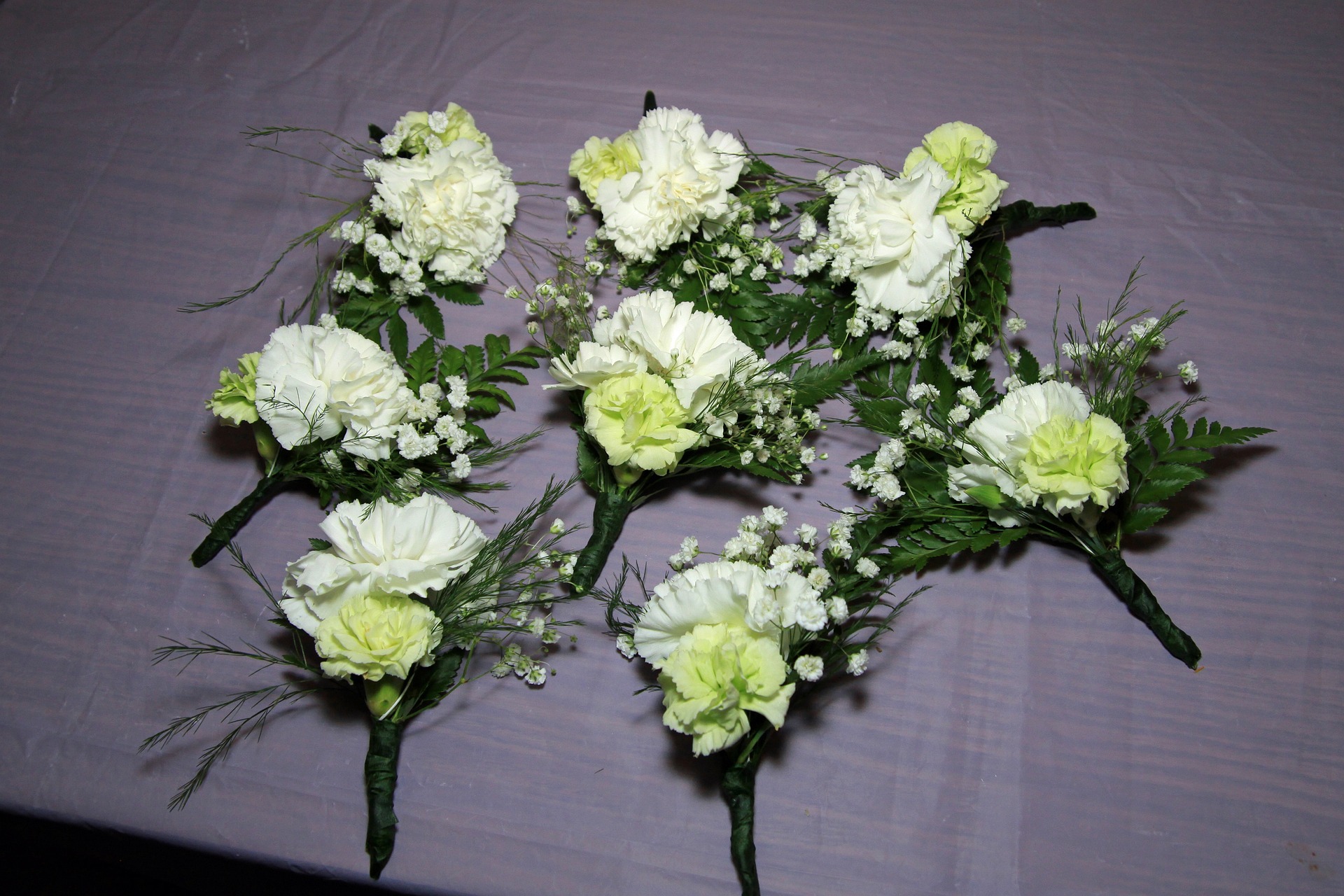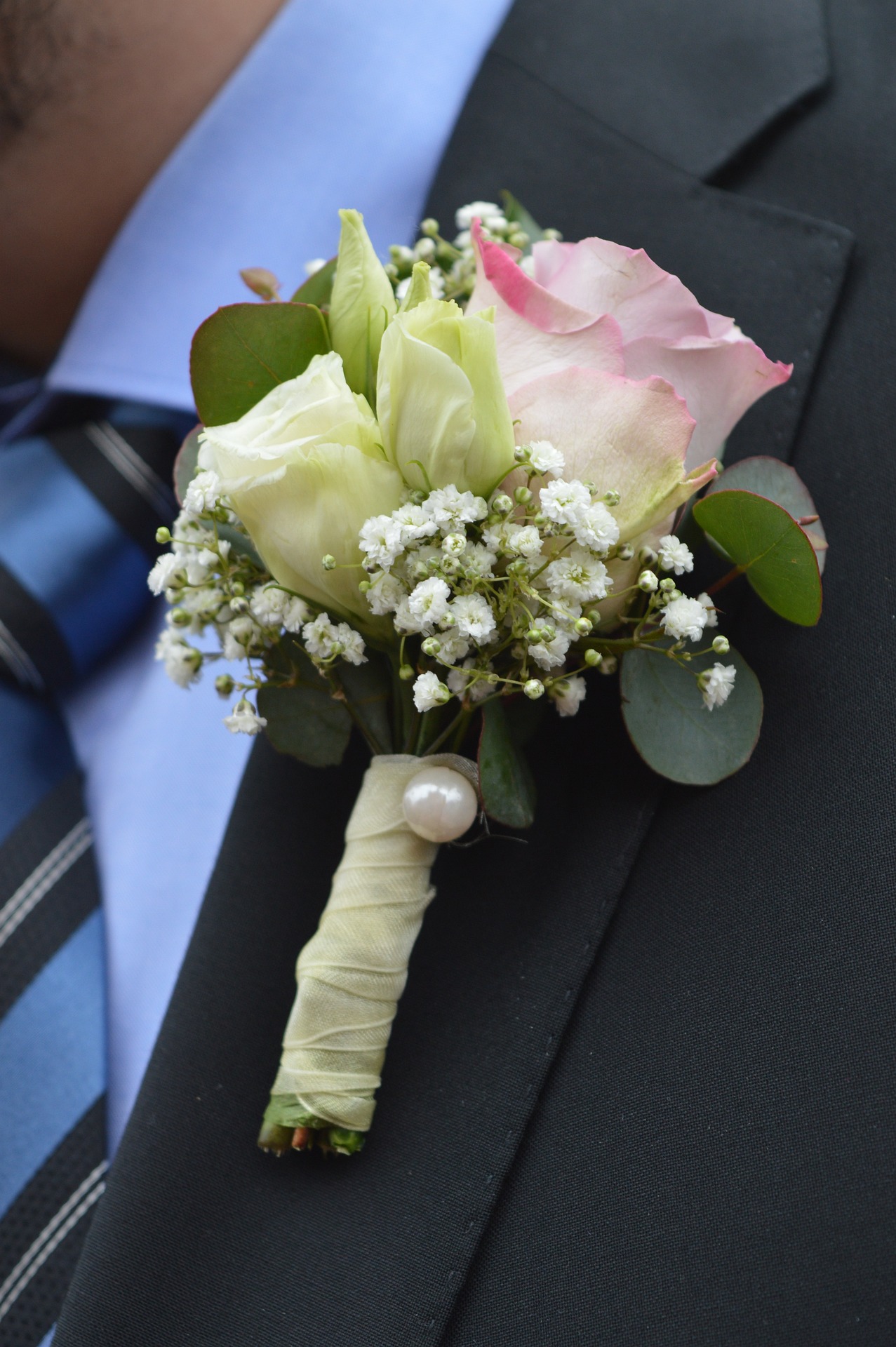A boutonnière (French: [bu.tɔ.njɛʁ]), sometimes known as a buttonhole in British English, is a floral design used on the lapel of a tuxedo or suit jacket.
While boutonnières were once worn often, they are now mainly saved for special events where formal attire is required, such as proms and weddings. (Women who wear coats on these occasions may also wear boutonnières, but they are more likely to use corsages.) Nowadays, lapel pins are more common than flowers on business outfits.
Traditionally, a boutonnière is worn through the lapel buttonhole (on the left, the same side as a pocket handkerchief), with the stem secured by a loop at the rear of the lapel. If the flower’s calyx is pronounced, as in a carnation, it should be entirely put into the buttonhole, securing it snugly and flat against the lapel.

To accommodate a standard-sized flower’s calyx, the buttonhole should be at least 1+1/8 inch (29 mm) long. Otherwise, the calyx would not fit into the buttonhole, allowing the flower head to hang freely and sway in the wind.
However, on many newer coats and jackets, the lapel is designed without a loop, which would traditionally go on the back of the lapel, beneath the buttonhole.
Sometimes the lapel buttonhole is in the “keyhole” shape rather than the traditional straight cut, or it is not even pierced through, in which case the boutonnière can be pinned onto the jacket lapel, though this may be considered unsightly, and continued pinning may eventually damage the cloth or silk facing.
History Of Boutonnière
The term boutonnière is derived from the French word for “buttonhole flower”. In the 16th century, boutonnières were employed to ward off ill luck and evil spirits, just like wedding bouquets do now. It was also used to repel undesirable odors and was thought to protect against disease.
In the 18th century, however, many people used boutonnières as fashion statements. They were attached to the buttonholes of frock jackets. In most regions of Europe at the period, it was customary for males to wear elegant clothing that featured not only a boutonnière but also breeches and boots. The French quickly began to adapt this design as well.
During the nineteenth century, boutonnières gained popularity among Romantic movement supporters, providing a burst of color to their clothes. This was one of numerous accessories that a man may put to his apparel to distinguish himself from the crowd, equivalent to selecting a pair of well-polished shoes. Other fashionable accessories were chains, cigar boxes, and diamond pins.
In the twentieth century, following World Wars I and II, wearing a flower on the lapel remained popular. Although boutonnières became less popular throughout time, they remained a mark of good breeding, elegance, and sophistication. This was partially owing to the influence of movies.
Today, boutonnières are still a component of a man’s formal dress, particularly for special occasions like weddings, proms, and ceremonies. When worn at a wedding or prom, they frequently match the flowers (corsages) of the bride or date. There are numerous types and styles of boutonnières to select from. In some situations, boutonnières are worn by the groom, his groomsmen, and the bride’s father, lending an air of luxury to the special occasion.
Flowers
The flower is generally a carnation, with white being the most formal. The classic option is one in clove red. Other colors and flowers, such as a blue cornflower, can be picked to better coordinate with whatever else is worn. A white gardenia is sometimes seen as a superior option to carnations, given its aroma and attractiveness.

Carnation boutonnières are traditionally worn by students attending formal examinations at the University of Oxford in the United Kingdom.
This boutonnière is worn on the lapel of the student’s subfusc, which is the university’s formal academic wear, but it is not required.
The color of the carnation shows the exam the student is taking during that run of exams. A white carnation is worn at the first examination, followed by a pink carnation at the intermediate examinations, and a red carnation at the final examination.








